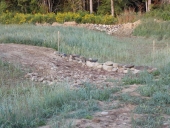UPDATE:
I think we're going into our 10th year of a vermicomposting toilet system, as pictured above, and here is some update information. I see some other threads are not using dirt for the worms. I guess the wood chips work, but I have no experience with that. I have plenty of dirt, though!
What and Why:
Vermicomposting in a Container involves dealing with the contents in the container. that flows out the out-flow pipe, in some manner. It is still black water even if the worms have worked on it. You'll have to look at it from time to time. You'll have to shovel it out and haul it away in buckets if it doesn't get the proper maintenance and packs up.
If you don't want to deal with effluent and maintenance then this may not be the method for you.
Worms can freeze, drown and bake if it's too hot in a container, which is easy to do. In some places where this can be a problem, the containers need to be buried but accessible. Worms live underground where it's about 50F/10C, that's what you want to achieve.
Because lots of liquids are flushed through this system, it's not the same as a worm box with paper and kitchen scraps.
Our pipes are 3"/7.5 cm. (the drawing shows 2", but that has changed.) Codes call for larger pipes, but we haven't had trouble with 3".
Where The Effluent Goes:
One person in Northern California had a vast network of buried drain pipes around redwood trees that the effluent went into. Redwood trees need hundreds of gallons of water a day, which they would already be getting, but he never had trouble sending the effluent around these trees. I don't know how he kept the roots out of the pipes, but maybe there's info on that somewhere.
Reed beds are a possibility. Reeds are rampant growers and roots can use the effluent and "clean" up the liquid, transform it from what it was. I'm not a biologist, but I bet there's still plenty of bacteria in reed bed water, but it's clearer than it was.
Reeds grow very fast in a container filled with wood chips, and need to be root-pruned probably once a year or they will get too full and burst the container. The reed beds don't smell bad. Even frogs hang out there sometimes, so it works for them. Some small communities in Canada use reed beds on a larger scale. Reed beds are also good for grey water. We have used them and they work well.
The effluent from a vermicomposting toilet might go into pipes that go into an orchard, or it might go into buckets that then go into an orchard, or a dehydrator, or a septic setup, or a reed bed, any number of things, but hopefully not out on the ground in general.
Never around annual vegetables that grow close to the ground like lettuce, tomatoes, zucchini, kale, parsley, etc. You don't want that kind of bacteria on or near your annual vegetables. You don't want it where pets and kids might wander through it. It's not fair for wild animals, either, to get it on their feet or their noses from sniffing it.
It shouldn't be uphill from any water source, lake, river, creek, spring or well. And that is true of grey water as well.
Why We Use Vermicomposting:
We use a vermicomposting toilet because we like one traditional, functioning, clean toilet for use inside, without odor, and without extra ingredients that need to be stored inside. In case someone needs to throw up they have a decent place in an emergency to do it. Not everyone is on the same page about composting toilets, so they have access to a regular toilet.
Our Experience With Composting Toilets Inside:
We do have composting toilets outside near our large garden and the area we usually picnic in. They are in outhouses with lots of ventilation and extra room for storing the compost or bags of ground-up wood chips.
Even though the composting toilets are in outhouses they still get huge numbers of gnats during a certain time of year. We've tried all the methods and still get them, so they don't work in a full-time location inside for us.
Even though composting toilets have the rep of "smelling like the forest," there is an undercurrent of ...you know... something else, and unless it's well vented, it's not that great to have it inside.
We've had trouble storing composting materials for an inside toilet because they have had bugs that then get loose inside, particularly ladybugs (who knew?)
It's a chore to keep amassing compost to add to it.
We don't like to buy peat moss (not good for the peat moss bogs of the world,) and bags of ground up wood chips or compost keep increasing in price. The stuff tends to fall out on the floor and it's just another chore to clean up after it.
Our System For The Last Ten Years:
The heavy-sided container is on a concrete pad (dry-pour works well to make a concrete pad,) or concrete stepping stones formed into a pad. The container becomes very heavy and needs support. The out-flow end is slightly lower so gravity flow sends all the extra effluent down to that end, and it drains between flushes, won't get a pool of liquid in the bottom that could drown worms.
The vermicomposting container doesn't get more than half full
- if it does, then either it needs more wet dirt to encourage the worms to reproduce and survive, or it needs more liquid going through it, or a bigger container depending on how many people use it.
The contents should never get so full that it blocks the in-flow pipe coming from the house, which should be in the upper third of the wall of the container, obviously!!
1/2 of the contents should be dirt for most of the year - add wet dirt accordingly
- For two of us I add one large bucket of wet dirt twice a year, pouring it on either side of the in-flow pipe so the incoming liquids don't wash out the dirt.. The worms will find it.
There needs to be enough liquid to make the contents flow down the out-flow pipe (which is going downhill) where it's been arranged to be dealt with it safely. We only put toilet flush liquid, kitchen sink liquid with non-laureth sulphate dish soap, shower water (with non-laureth sulphate shampoos,) and bathroom sink water. Toothpaste hasn't caused a problem.
We've bypassed the washing machine water out into grey water lines that go to large, landscape perennial trees because of the high level of soap involved. We don't use detergent, and it's unlikely worms could live with that in their environment. We don't want detergent in our soil anyway.
How It Looks When It's Working:
Inside the container it should look like a writhing, seething, moving well-mixed mass that is sloppy but not liquid. Worms can drown, so it shouldn't be too full of liquid, and adding wet dirt keeps the balance. You want to keep most of the worms in the box. You may or may not see worms, but those guys are what are making the writhing movement, and that means there's enough of them.
When It Goes Wrong:
If it's not writhing, and it's packed, then there isn't enough dirt and liquid, and probably most of the worms are dead. Worms won't go into just the contents. Worms need dirt.
Without the worms doing the job, the contents will pack and block up the outflow pipe, and you'll be spending the day shoveling it into buckets and hauling those heavy buckets off somewhere safe, and snaking the outflow pipe. So a little maintenance once or twice a year will save you.
In Canada some friends of ours use a big septic pit under the bathroom or outhouse filled with worms that can retreat under the frostline in winter. Septic pits are illegal in a lot of other places, so check with your local codes. A big pit with worms may not need as much maintenance as a container because the pit is surrounded by dirt for them.
When It Gets Out of Balance:
If the container gets out of balance, packs up, and has to be shoveled....
It's still full of bacteria you don't want to come in contact with.
- Wear old rubber boots,
- use rubber gloves or disposable vinyl gloves (but they tear easily),
- wear old pants
Don't wear a good hat that could fall off your head when you bend over to adjust something and it falls into the container! If that happens, rinse it off with a hose immediately. Been there, done that!
Don't have cuts or blisters on your hands
Don't touch nose, eyes, mouth, ears until you have cleaned up with plenty of soap and water, and hand sanitizer if possible.
Have at least two large buckets for hauling
Use a septic line snake, or a disposable stick to stir up the blockage in the pipe while you add water to inside the container near the out-flow pipe to flush it out.
Rocks inside the container around the out-flow pipe help give you access to that pipe and stop any contents that starts to pack up from blocking that pipe. Use rocks that are bigger than the outflow pipe, but not so big and heavy they will make the container bulge sideways as the stuff fills in around them. The rocks aren't foolproof, but they help. The gaps between the rocks should be large enough to let liquidy contents flow past them and out the out-flow pipe, but not so big that too much of the contents flows down the pipe and fills it up.
Bricks are not a good idea because they create a barrier that the liquid contents cannot get past. Chunks of concrete and rocks with odd shapes leave good-sized gaps when stacked akimbo.
Occasionally worms are washed out of the container but it's not a problem. If you see dead worms being washed out of the container, check the contents, make sure there's enough dirt, and that it's liquidy enough to flow out.
Install a Y flush-out fitting with a removeable cap on the Y part, in the out-flow pipe a couple feet from the container so you can snake back up into it if something goes wrong.
Cleaning Up:
When you're done, clean thoroughly shovel, buckets, boots, and septic line snake.. Throw away the sticks. Use lots of soap and water on your hands and arms, and use hand sanitizer. Don't wash your pants in the same laundry load as other clothing.
It will take the worms a few weeks to reproduce and get things in balance again.








